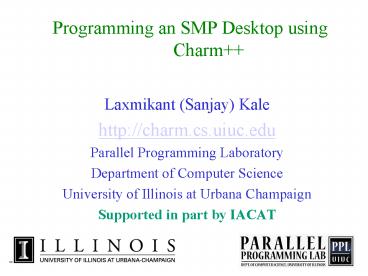Programming an SMP Desktop using Charm - PowerPoint PPT Presentation
1 / 19
Title:
Programming an SMP Desktop using Charm
Description:
I will present an abbreviated version of the planed talk. We are running late.. Also, I realized that what I really intended to present, with code examples, ... – PowerPoint PPT presentation
Number of Views:32
Avg rating:3.0/5.0
Title: Programming an SMP Desktop using Charm
1
Programming an SMP Desktop using Charm
- Laxmikant (Sanjay) Kale
- http//charm.cs.uiuc.edu
- Parallel Programming Laboratory
- Department of Computer Science
- University of Illinois at Urbana Champaign
- Supported in part by IACAT
2
Prologue
- I will present an abbreviated version of the
planed talk - We are running late..
- Also, I realized that what I really intended to
present, with code examples, will need an hour
long talk.. - We will write that in a report later (may be put
it in charm documentation)
3
Outline
- Charm designed for portability between shared
and distributed memory - Optimizing multicore charm
- K-neighbor and its description and performance
- What optimizations were carried out
- Abstractions
- Basic shared object space, Readonly data
- Plain global variables still work.. More on
disciplined use of these later - Nodegroups
- Passing pointers to shared data structures,
including sections of arrays. - Readonly, write-exclusive permissions by
convention or capability
4
Optimizing SMP implementation of Charm
- Changed memory allocator
- to avoid acquiring a lock per memory allocation
- Reduced the granularity of critical region
- Used thread local storage (__thread) to avoid
false sharing - Use memory fence instead of lock for pcqueue
- Reduce lock contention by using a separate msg
queue for every other core on the same node - Simplify the data structure of pcqueue
- Assumes queuesize is adequately large
5
Results on SMP Performance
- Improvement on K-Neighbor Test (8 cores, Mar2009)
6
Results on SMP Performance
- Improvement on K-Neighbor Test (24 cores,
Mar2009)
7
Results on SMP Performance
- Improvement on K-Neighbor Test (16 cores,
Apr2009)
8
We evaluated many of our applications to test and
demonstrate the efficacy of the optimized SMP
runtime
9
Jacobi 2D stencil computation on Power 5
(8000x8000 matrix size)
10
ChaNGa Barnes-Hut based production astronomy
code
11
ChaNGa Barnes-Hut based production astronomy
code
12
NAMD Scaling with Optimization
NAMD apoa1 running on upcrc
13
Summary of constructs that use shared memory in
Charm
14
Basic Mechanisms
- Chares and Chare array constitute a shared
object space - Analogous to shared address space
- Readonly globals
- Initialized in mainmain or any method called
from it synchronously - Shared global variables
15
More powerful mechanisms
- Node groups
- Passing pointers to shared data structures,
including sections of arrays. - Readonly, write-permission
16
Node Groups
- Node Groups - a collection of objects (chares)
- Exactly one representative on each node
- Ideally suited for system libraries on SMP
- Similar to arrays
- Broadcasts, reductions, indexing
- But not completely like arrays
- Non-migratable one per node
17
Conditional packing
- Pass data structure between chares
- Pass pointer (dest. within the node)?
- PUP the entire structure (dest. outside the
node)? - Who owns the data and frees it?
- Data structure must inherit from CkConditional
- Reference counted
- A data structure can contain info about an array
section - Useful in cases like in-place sorting (e.g.
quicksort)?
18
Sharing Data and Conditional packing
- Pointers can be sent in messages, but they are
packed to underlying data structures when going
across nodes - (feature in chare kernel since 1989 or so!)
- Data structure being shared should be
encapsulated, with a read or write capability - If I give you write access, I promise not to
modify it, read it, or grant access to someone
else - If I give you a read access, I promise not to
change it until you are done
19
Disciplined Sharing
- My pet idea shared arrays with restricted modes
- Readonly, write-exclusive, accumulate, and
owner-computes - Modes can change at well-defined global synch
points - Captures a large fraction of uses of shared
arrays

